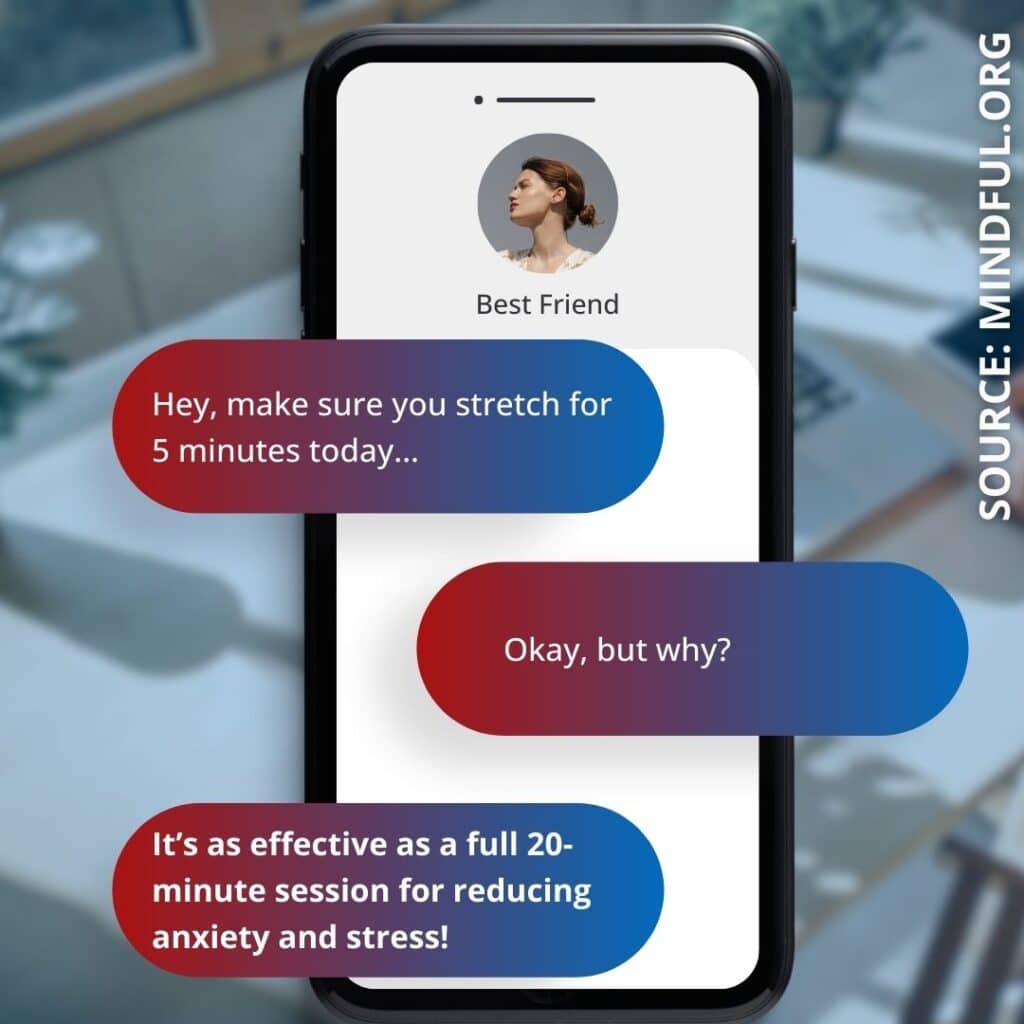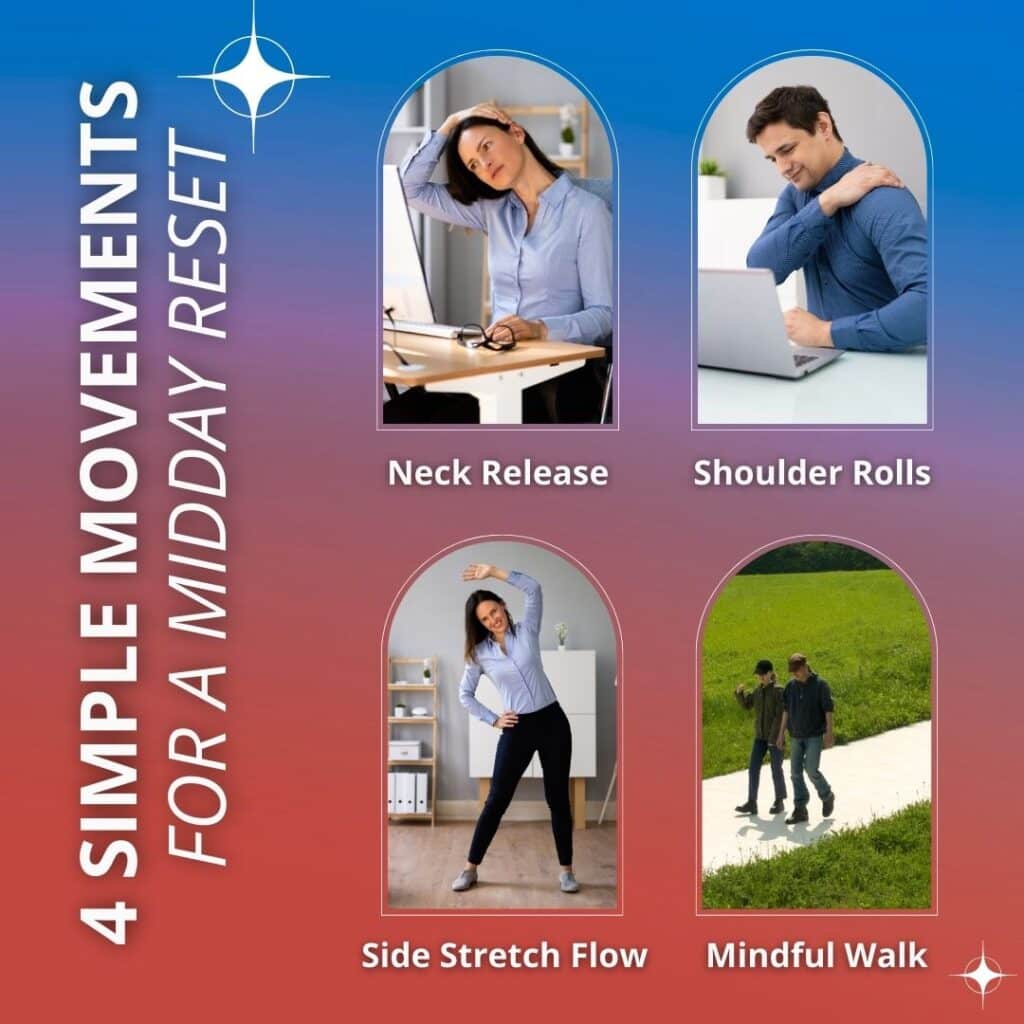Here’s the scoop on mindful movement, why it works, and how you can use it at any time to reset your mind and body. Stress can build up in both your mind and your body.
It often shows up as tense shoulders, shallow breathing, fatigue, and difficulty concentrating. When this happens, you do not always need a long workout or an hour of meditation.
A few minutes of mindful movement can help you release tension, regain focus, and feel more balanced. The movements are simple, require little or no equipment, and can be done anywhere: let’s get started.
What Mindful Movement Looks Like in Real Life
Mindful movement means focusing on each action your body takes, along with your breathing and physical sensations. The goal is not speed or intensity, but awareness and control.
Some examples:
- Yoga or tai chi practiced slowly with attention to breath
- Walking while noticing each step and your surroundings
- Stretching and observing how each muscle feels as it lengthens
Even daily tasks such as standing from a chair or reaching for something on a shelf can become mindful if you slow down and focus on how your body moves.

Why It Works
1) It Eases Physical Tension
Stress often causes the body to tighten, especially in the shoulders, neck, and back. Gentle, controlled movements increase blood flow, loosen muscles, and help the body release tension.
2) Helps Calm the Mind
By focusing on your movements and breathing, you give your brain a break from constant thoughts and distractions. This helps lower stress and improve mental clarity.
Short mindfulness sessions (even 5-minute bursts) are as effective as longer sessions (20 minutes) in reducing depression, anxiety, and stress.
3) Improves Posture and Balance
Mindful movements encourage better body awareness. Over time, this can improve your posture, balance, and the way you carry yourself throughout the day.
4) It Boosts Your Energy
Moving in a slow, intentional way increases circulation and oxygen flow, which can help you feel more awake and alert without relying on caffeine.
Simple Mindful Movements to Try Anytime
Seated Neck Release
Sit up straight with both feet on the floor. Slowly tilt your head to the right, bringing your ear toward your shoulder. Hold for three slow breaths, then repeat on the other side. Focus on releasing tension with each exhale.
Shoulder Roll Sequence
Sit or stand tall. Lift your shoulders up toward your ears as you breathe in, then roll them back and down as you breathe out. Repeat five to eight times, paying attention to the release of tension.
Side Stretch Flow
Stand with feet shoulder-width apart. Inhale and raise your right arm overhead. Exhale and lean gently to the left. Hold for a few breaths, then return to center and switch sides.
A Mindful Walk
Walk slowly and notice each step. Feel your feet connect with the ground and match your pace to your breath. This can be done indoors or outside for one to five minutes.

Building Mindful Movement Into Your Day
Mindful movement works best when it becomes part of your daily routine. You can:
- Use it as a mind and body reset before a big meeting or presentation
- Add it to your morning routine to set a calmer tone for the day
- Take short mindful movement breaks during long work sessions
- Practice before bed to release the day’s tension and prepare for restful sleep
Even two or three minutes at a time can make a noticeable difference.
Related Questions About Mindful Movement
Can mindful movement replace a regular workout?
It can complement a workout but is not meant to replace all forms of exercise. Mindful movement focuses on awareness and gentle activity, while regular workouts may target strength, endurance, or cardiovascular health.
How long should a mindful movement session be?
Even two to five minutes can help reduce stress and tension. Longer sessions, such as fifteen to thirty minutes, can provide deeper benefits for both mind and body.
Is mindful movement suitable for beginners?
Yes. These movements are accessible for all fitness levels and can be adapted for those with limited mobility. Beginners can start with simple stretches and breathing exercises, then add variety over time.
Can mindful movement be done at work?
Absolutely. Desk-friendly stretches, short walks, or seated breathing exercises are easy to integrate into a workday. This is especially helpful for improving posture and reducing mental fatigue.
Does mindful movement help with focus?
Yes. By centering attention on movement and breath, you shift your focus away from distractions. This mental reset can improve clarity and productivity afterward.
When to Get Support
Mindful movement can be done on your own, but there are times when guidance can make a big difference! If you are struggling to stay consistent, unsure which movements are best for your needs, or want to combine mindful movement with a larger wellness plan, it can help to work with a professional.
Mile High Fitness & Wellness offers one-on-one and group sessions that blend mindful movement with other wellness practices such as strength training, yoga, and stress management techniques. This approach not only helps you build a routine but also ensures you are moving safely and effectively.
Whether you are looking to reduce stress at work, improve mobility, or boost daily energy, structured guidance can help you reach your goals faster and with more confidence.
Conclusion
Mindful movement is a practical way to reset both your mind and body, even when time is limited. It helps you release tension, sharpen focus, and restore energy, often in just a few minutes.
The more often you integrate it into your day, the easier it becomes to reset whenever you need it.
If you are ready to explore mindful movement as part of a bigger wellness plan, Mile High Fitness & Wellness can help you create an approach that fits your lifestyle, schedule, and goals.



